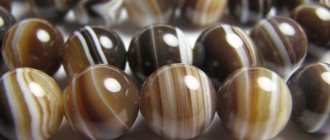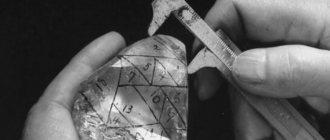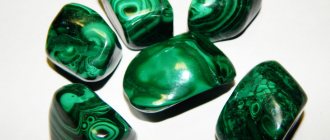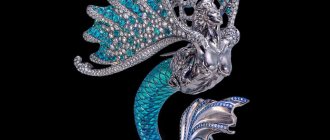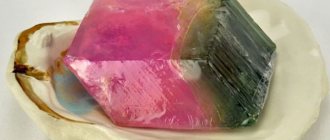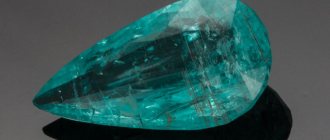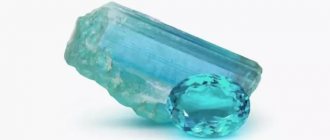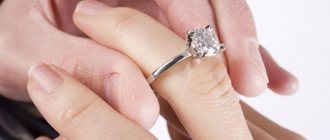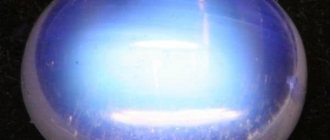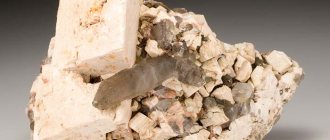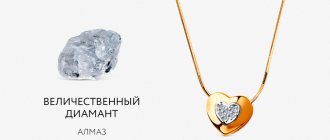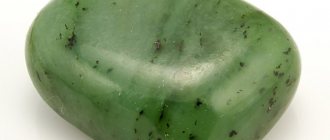Scientists cannot determine the exact period when people began to use precious stones. But it is known for certain that the first mentions of jewelry are found in the Bible. In ancient times, jewelry indicated belonging to a certain class of society. Many believed that stones could protect against evil spirits, troubles and diseases. Ancient Egyptians back in the 4th century. BC. they knew how to process minerals and decorated them with amulets, hats, and even made patterns on the walls. Later, humanity learned to categorize stones according to their value depending on several factors: color, brightness, rarity, and most importantly, hardness. Let's figure out how the value of stones is estimated in modern times and get acquainted with their 20 best representatives.
Musayif Diamond
Our ranking of the most expensive precious minerals opens with a red diamond, which was previously called the Red Diamond Shield. Today it is called the Musayif Red Diamond.
This largest blood red diamond weighs 5.11 carats. It was first shown to the public at the Smithsonian Exhibition in 2003.
The stone was mined in the 1990s from mines in Brazil. The jewelers decided to approach its cutting with special care - they gave it the shape of a triangle.
The average price per carat for red diamonds reaches $1 million. The high cost is justified by their rarity - today there are only 50 pure copies in the world.
Rating of expensive minerals
Precious stones differ in appearance, shape, color and strength. The list shows the characteristics of the most expensive of them:
Red diamond
Rarely beautiful, a desirable catch for collectors. The most expensive gemstone is mined only in Australia, from the Argyll source, only a few copies per year. The largest red diamond ever mined is on display at the Smithsonian Exhibition. Its weight is close to 5 carats. Stone is formed from the chemical element carbon. He is very strong. The red diamond is valued at $1 million per carat.
Grandidierite
The second most expensive stone is named after the scientist who discovered the mineral in the wild. It has three colors: white, blue and green. About 20 such minerals have been found on the planet. The price of grandidierite is 100 thousand dollars per carat.
Padparadscha
The name of the mineral translates as “Sunrise”. Padparadscha is mined in two places on the planet: on the island of Madagascar and in Tanzania. A stone of unusual beauty and color. For its purchase, collectors pay from 30 thousand dollars per carat.
Jadeite or imperial
The stone managed to leave its mark on history: jadeite was worshiped by the Aztec Indians. The emerald Buddha statue in Thailand is also made from it. The price of jadeite is 20 thousand dollars per carat.
Diamond
Few people have not heard of this gem. In culture, diamond has become a metaphor for purity and hardness. Diamond prices depend on its natural properties. The cheapest costs 15 thousand dollars per carat. By the way, the oldest stone is 2.5 million years old. The famous mineral got its name from Arabic.
The translation of the word “al-mas” means “the hardest.” The raw mineral was considered a valuable decoration and monetary value. According to one version, the stone was formed under the influence of magma. In the depths of the Earth, carbon atoms form diamonds, and then magma rises to the surface.
According to the second, they flew to Earth as part of meteorites. Precious stones exist in varying quantities on all continents, but their extraction sites are not always of equal importance. As a rule, diamonds are found in rock formations.
A diamond becomes truly valuable after it has been cut into a jeweler. During the processing process, the master removes defects and irregularities and smoothes the surface. Sometimes processing takes several years.
Precious ruby
The closest analogue of sapphire. Ruby has a red color. Stone deposits have been found on almost all continents. Natural rubies mined in Asia are of great value. Their cost starts from 15 thousand per carat.
Paraiba tourmaline
In the past, the deposit of this stone was located only in Brazil. Later, mining sites were discovered in Africa and Madagascar. The price of a small tourmaline is 15 thousand dollars. The gemstone has an indescribable neon glow.
Alexandrite
The stone was first discovered in the 19th century near Yekaterinburg. It was named in honor of Alexander II, the ruler of Russia. Alexandrite can change its color. The cost of the mineral ranges from 10 to 37 thousand $ per carat.
Bixbit
Deposits of this mineral are located in the states of Utah and New Mexico. During all this time, only a few specimens of bixbit were recovered. One carat of the mineral costs 10-12 thousand dollars.
Emerald and sapphire
The cost of the emerald is 8 thousand dollars per carat. There are quite a few pure examples. The price of sapphires starts from 6 thousand.
Bahian emerald
The emerald from the Brazilian province of Bahia is the largest such stone ever mined in the world. It weighs 1.9 million carats - approximately 380 kg.
In 2005, it was stored in a warehouse in New Orleans (USA) and was miraculously saved from disappearing during the rage of Hurricane Katrina. He was later transferred to custody in Los Angeles, where they tried to protect him. But in 2008, it was stolen by a dealer, as reported in the media.
According to experts, the huge emerald should cost more than $400 million. But just recently, an anonymous seller put it up for sale on eBay for a “ridiculous” price of $75 million.
Since there were no people willing to urgently buy the Bahian emerald, the police had the opportunity to detect the thief. Today, the stone was successfully recovered and is in the possession of the Los Angeles Police Department.
Where is it used?
The value of the stone determined the areas of application:
- Investment object. The cost of Paraiba grows every year. The less raw materials remain in the deposits, the faster the price rise process (+20-30% annually). Even stones from Africa are suitable, not to mention real Brazilian ones.
- Jewelry. Blue or turquoise stone goes well with gold and platinum.
Ring with Paraiba tourmaline
Earrings, a pendant, a ring, a ring with Paraiba tourmaline will immediately indicate the status of the owner.
- Collecting. Raw samples from various mines on the planet are a worthy goal for a collector. And also a reliable investment.
In all cases, you need to carefully study the accompanying documents for the stone so as not to buy a fake.
Blue Diamond
Another representative of the family of the most breathtaking diamonds both in beauty and price. It received such a high price, which was paid for it at the Sotheby's auction, thanks to its unique color and impeccable cut.
Such stones are rare in the world, so it was sold for $8 million. The most beautiful diamond became the most expensive in the world, if you compare the cost of one carat. This representative was valued at $1.32 million per carat. Not everyone can pay that amount for 0.2 g of stone happiness.
The weight of the diamond is 6.04 carats. Previously it belonged to a private collector. But in 2007, at an auction in Hong Kong, it was purchased by a representative of the Moussaieff Jewelers jewelry house, whose main office is located in London.
How stones are valued
“It is better to have old used diamonds than to have none at all,” Mark Twain.
I wonder why Mark Twain mentioned diamonds? Everything is very simple. At all times, exchange rates changed frequently, and prices for precious metals varied depending on the country, political and economic situation. And only the price of precious stones always remained at a high level.
Key criteria for evaluating a stone:
- weight (measured in carats);
- color;
- purity;
- cut.
Weight
Initially, weight was measured using scales with bowls, but now electronic ones are used. Interestingly, the shape of the finished product depends on the raw material. This happens because cutting off a lot is unprofitable, because the weight decreases during processing. For example, nature has an abundance of amethyst, so jewelers do not skimp and give the stones any shape. And it is labor-intensive to obtain a product larger than 1 carat from a ruby, so cutting is done depending on the structure, trying to maintain the original weight.
1 carat = 0.2 grams.
Color
Modern jewelers, like their predecessors, pay close attention to color, namely:
- shade;
- saturation;
- tone.
Jewels of pure colors are valued many times higher than those that are too dark, bright or pastel.
Purity
When checking cleanliness, pay attention to external and internal damage: scratches, chips, foreign particles, liquid and gaseous substances. Such defects affect not only the price, but also the duration of operation. The purity of transparent stones is determined according to the international GIA scale. It has several levels from “No distortion” to “Clearly visible distortion”.
Cut
There are 3 basic types of cuts:
- cabochon;
- circle;
- facet.
Each species has subspecies. In total, there are more than 500 cutting options; the shine depends on the processing. If the master makes too small or deep edges, the price decreases. But only professionals can spot defects.
Rough but very valuable diamond
The list of the most expensive jewelry in the world includes a diamond that has not yet been cut. It is very massive - its weight reaches 478 carats. Until now, there has not been a jeweler who would undertake its processing. But experts say that in the future it could produce a flawless 150-carat diamond that could rival the most expensive jewel in the world - the Koh-i-Noor stone. You can still read about it further.
The stone was discovered in a mine in Lesotho, in the southern African continent. Its deposit is considered one of the most “lucky” ones when it comes to discovering large diamonds. Previously, minerals weighing 600 and 500 carats each were mined here.
Storage and care rules
Real Paraiba tourmaline is very expensive, so you need to treat it with care:
- protect from any mechanical impact, moisture, heat and sun;
- store separately from other minerals in a box with soft upholstery;
- take pictures at home, before visiting the sauna, swimming pool and gym;
- avoid contact with chemicals;
- Entrust stone cleaning to professionals.
Synthetic samples have less demanding care requirements - they can be worn in everyday life.
Ethereal Carolina Divine Paraiba
A very rare and beautiful Paraiba tourmaline stone called Ethereal Carolina belongs to Vincent Boucher, a Canadian financier. Experts estimate the stone, weighing 192 carats, at $125 million.
Neon blue minerals are mined in Brazil at the Batalha mine. Therefore, the stone was named after the province where most tourmalines are found. The rarity of the mineral is confirmed by statistics - only 50 kg have been found in the world throughout history. such jewelry.
In 2001, a new tourmaline deposit was discovered and it is located not in Brazil, but in Nigeria. The stones are small in size, but due to their rarity they are very expensive.
Physicochemical characteristics
Paraiba tourmaline is an aluminum borosilicate containing significant amounts of iron and magnesium. This is the only mineral in which a small amount of gold is present.
Characteristics of Paraiba:
| Index | Characteristics |
| Admixture of copper and manganese | The color of Paraiba is provided by an admixture of copper (at least 1.2%) and manganese (at least 2.5%). Samples with smaller amounts of these elements are classified as indigolites, which have less value and different properties. |
| Hardness | 7-7.5 units on the Mohs scale |
| Density | 3.2 g/cm³ |
| Transparency | Translucent, completely transparent |
| Kink | Conchoidal |
| Shine | Glass |
| Light refractive index | 1,62-1,64 |
Graff Pink
Diamonds themselves are very expensive stones. At the same time, minerals with unique colors are especially valued in the world.
One of these is the Graff Pink diamond. Its cost reaches 45 million dollars. Moreover, the stone weighs only 24.8 carats.
The stone was sold at Sotheby's auction in 2010. Its lucky owner was British billionaire and gem expert Lawrence Graf. He became the first person in the world to pay such a high price for a precious stone.
Alexandrite, No. 5
Deposits: India, Tanzania, Brazil
Alexandrite owes its name to Count Perovsky, who named this stone in honor of the then heir to the throne, Alexander II. The count presented it to the prince on his sixteenth birthday. Russian alexandrite is the most famous in the world, since a significant amount of this mineral was mined in Russia until the end of the 19th century. However, subsequently the sources of alexandrite deposits in the country dried up, and today the stone is mined in the mountains of India, Tanzania, Brazil and other countries.
Alexandrite is interesting because it can reflect three different colors: green, red and yellow, depending on the viewing angle. Its curious and cheaper variety is the cat's eye. This version of the stone reflects light, producing an effect similar to a cat's pupil.
Pearl fluorite
The largest pearl in the world is called a faceted round fluorite stone. The public was able to see the 6-ton jewel in China at the end of 2010.
To make a “pearl” from an uncut mineral, jewelers from Hainan province worked for 2 years. It is noteworthy that the diameter of the stone reaches more than 1.5 m and it glows green in the dark.
Until now, there has not been a person who would want to possess this jewel. Most likely, those interested do not have the required amount - the stone was valued at $300 million.
Medicinal properties
The energy of Paraiba tourmaline also has a beneficial effect on health. It is used for:
- normalization of the nervous system and psycho-emotional background;
- increasing immunity;
- improved sleep and appetite;
- restoration of metabolism.
This type of tourmaline has contraindications. You should not wear jewelry with this stone under the following conditions:
- at elevated body temperature;
- in cases where a pacemaker is installed;
- for diseases of the endocrine system;
- for soft tissue injuries.
Women during pregnancy and breastfeeding should be careful when coming into contact with the stone. It is not recommended to wear Paraiba all the time, and if you experience any discomfort or deterioration in your health, you should completely discard the mineral.
Don Pedro
The precious crystal that opens the top three of our ranking is an aquamarine 35.5 cm long. It can be admired at the Washington Museum of Natural History, which belongs to the Smithsonian Institution. Next to it are exhibits such as earrings with precious stones that once belonged to Marie Antoinette and the magnificent Hope Diamond.
Previously, the mineral belonged to Florida businessmen J. Bland and J. Mitchell. They wished to donate the jewelry and gave it to the museum in 2011.
The stone was found in Brazil in early 1980. It was originally an uncut beryl crystal weighing 27 kg.
It was named in honor of the first Brazilian rulers of the 19th century - Don Pedro I and his heir Don Pedro II. The stone was cut by a talented jeweler from Germany, Bernd Münsteiner, who gave the stone the appearance of an obelisk. The total weight of the jewelry is 10.3 thousand carats. This is a unique aquamarine - there is no one like it in the world.
Artificial Paraiba: how to distinguish a fake
Ring with sital made of red gold
The high demand and high cost of Paraiba contributed to a number of experiments on the production of synthetic analogues. Of all the methods, the most common are:
- Heating the green crystal to 600°C and acquiring a blue tint. This sample does not have a neon glow.
- Prolonged heating of violet tourmaline in an oxidizing environment. As a result, the stone becomes discolored, and its surface layer glows with a greenish tint. To identify such an artificial stone, it is enough to carefully examine it under a microscope.
- Green tourmaline is subjected to electrophoresis using copper sulfate. The disadvantage of this method is that copper is not absorbed into the structure of the stone and even with a slight scratch the imitation will be revealed.
- Purple tourmaline, after heating to a certain temperature, is subject to irradiation. Such a counterfeit is almost impossible to detect visually; this will require special equipment.
There is also nano-technology for producing artificial tourmaline from quartz rocks and metal particles. Small grains of natural rocks from the quartz category are fused with microscopic metal particles.
Such samples are called glass ceramics and are used in the manufacture of jewelry. In terms of hardness and appearance, glass ceramics are practically no different from real Paraiba tourmalines.
Millennium
The second place in our rating is occupied by sapphire, which weighs 61 thousand carats. Its size can be compared to a soccer ball. Experts say that the price of the jewelry cannot be less than $180 million.
The place where he was found was the island of Madagascar. There, in 1995, searchers discovered a huge stone that weighed 90 thousand carats. Naturally, after cutting its size decreased, but this fact still does not affect the fact that Millennium is the largest sapphire in the whole world.
The mineral received its name due to skillful cutting that lasted for 2 years. On its surface, the famous Italian jeweler Alessio Boschi decided to engrave images of personalities who made a special contribution to the development of humanity. There you can see Michelangelo, Beethoven, Einstein, Martin Luther King Jr. and a number of other figures who became legends of past centuries. In total, 134 portraits are carved on it.
The general public was able to admire the gem only twice. He was put up for inspection in 2002 and 2004.
Reference tables for market valuation of jewelry stones
The table below shows the color characteristics of popular jewelry stones, their prices and availability. Prices are given only for faceted jewelry stones. Stones cut in the cabochon style are often cheaper. Prices are given for stones of “good” and “extra-high” quality. Commercial quality stones that are used in mass produced items cost significantly less. Prices are given in a range. Moreover, the greater the spread of prices for any stone, the greater the importance of qualitative differences in gemological characteristics.
Market prices for jewelry stones
| Name of the stone | Color | Market prices (retail) USD per carat | Availability |
| aquamarine | pale blue to moderate blue | 1-5 ct: 50-600 5-10 ct: 170-1200 | Often in stock |
| emerald | yellow-green to bluish-green | 1-2 ct: 1150-18000 2-4 ct: 2000-25000 | high quality ones are rare, others are usually available for sale |
| alexandrite | changes color from greenish in daylight to reddish in incandescent light | 1-2 cart:2200-18000 | large ones are rare |
| ruby | from red to yellow-red | 1-2 ct: 900-10000 2-4 ct: 1800-32000 | high-quality ones with natural color are very rare |
| blue sapphire | bright blue to inky blue | 1-2 ct: 300-2900 2-4 ct: 1200-14000 | Kashmiri ones with natural color are rare, others are quite common |
| green sapphire | pure green to yellowish green | 1-3 ct: 40-180 3-5 ct: 100-220 | Pure green color is rare, others are quite common |
| pink sapphire | light to dark pink | 1-2 kt: 600-4800 2-3 kt: 800-5600 | with a weight of up to 1 carat it is quite common |
| yellow sapphire | yellow (most stones are heat treated | 1-5 ct: 120-1200 5-10 ct: 400-1500 | large ones are rare, others are at a good level |
| Moonstone | Milky white to bluish white | Up to 1 carat: 50-180 3-4 carats: 800-1200 | white is at a good level, other colors are at a satisfactory level |
| garnet (almandine) | purplish red to pure red | 1-5 ct: 10-40 5-10 ct: 16-60 | at a satisfactory level |
| garnet (demantoid) | from yellow-green to bright green | 1-2 cart: 800-1800 2-3 cart: 2000-12000 | at a satisfactory level |
| garnet (rhodolite) | red-violet | 1-5 ct: 20-180 | at a satisfactory level |
| garnet (spessartine) | brown-orange to reddish-brown | 1-5 cart: 8-60 5-30 cart: 24-160 | nAt a satisfactory level |
| pearls cult. round | silver, silver-white, white, cream | threads 6-6.5 mm:500-2000 8-8.5 mm:1700-11000 9-9.5 mm:4400-27000 | high quality more than 8 mm is rare |
| pearls cult. South Sea | silver, silver-white, white, cream | for one pearl 11-12 mm: 1500-5600, over 16 mm: 12500-25000 | high quality more than 16 mm is rare |
| pearls cult. rice | all colors | standard threads: 5-20 | at a good level |
| Pearl cult. Tahiti | black dark gray to greenish undyed | for one pearl 9-10.5: 800-3600, over 12 mm: 2500-5000 | small at a good level of high quality more than 10 mm is rare |
| peridot (peridot) | yellow-green to dark green | 1-5 ct:25-150 5-10 ct:50-130 | Large ones are rare |
| amethyst | from violet-red to dark purple | 1-5 ct: 6-125 5-20 ct: 10-150 | at a good level |
| citrine | yellow to yellow-brown | 1-20 ct: 5-60 | at a good level |
| spinel | pink-red-brown | 1-3 ct: 70-1200 3-5 ct: 150-4000 | at a good level |
| blue topaz | blue, bright blue | 1-5 ct: 2-16 5-20 ct: 200-1600 | at a good level |
| pink topaz | pink, yellowish pink | 1-3 ct: 150-1500 | at a good level |
| tourmaline | wide color range | 1-3 ct: 40-360 5-10 ct: 120-800 | at a good level |
| zircon | pale blue (usually cooked) | 1-5 ct: 30-300 5-10 ct: 70-500 | at a good level |
| noble white opal | with opalescence in blue and green tones | 1-12 ct: 50-170 | at a good level |
| fire opal | bright orange | 1-10 ct: 200-1400 | at a good level |
All gemologists, regardless of their experience, from time to time encounter a stone that they cannot clearly identify. This situation requires consultation with another gemologist or gemological laboratory. In such a case, inform your client of the identification problem and delay the evaluation until the issue is resolved.
In some cases, frames may prevent clear identification. In order to solve this problem, you just need to remove the stone from the setting. Be sure to obtain a written release of liability from your client before beginning this procedure.
Koh-i-Noor
The winner of our rating is a real jewel - a royal diamond. It adorns the crown of the British Queen and weighs 106 carats.
This mineral has no price, but has a rich history. At one time it belonged to Indian rulers, then still weighing 186 carats. But the larger and more expensive the diamond, the more people who want to become their owner.
Today, among other similar expensive jewelry, it belongs to the British royal family. In 1852, Prince Albert became the first owner of the Kohinoor, but he was not satisfied with the cutting of the stone. Therefore, he personally went to Holland to see the skilled jeweler Cantor. After cutting, the stone lost a little of its weight, but became much more beautiful. After which the prince gave it to his wife Victoria, who in the future wished to include it in the decoration of her crown.
Collectors, royalty and simply the rich often become owners of the most expensive things on the planet. But only precious stones that have been created by nature over millions of years can be so valuable.
For a small stone that fits in the palm of your hand, a buyer can pay millions of dollars. But this is an excellent financial investment, because precious stones only become more expensive over time, and more and more people want to become their owners.
Origin of the gemstone
Historically, stones from certain deposits are taken as the standard for the quality of a particular stone. Thus, rubies from Burma, sapphires from India, and emeralds from Colombia are considered the most prestigious and beautiful. The price of such stones may have a premium to the list price of up to 30%.
Emerald from Colombia
It is quite difficult to establish from which deposit a particular stone was mined. Evidence must be based on in-depth studies of the various types of inclusions and defects that stones from different deposits have. But there are some features that suggest the place of origin.
Thus, the presence of chromium as a coloring agent in Burmese rubies is often the reason for their strong luminescence, which is noticeable under artificial light. This luminescence makes the color of the stone more saturated; often the stone seems to be illuminated from within, flickering like a hot coal. In daylight, such a stone may appear pale pink. The same applies to rubies from Sri Lanka.
Thai rubies owe their color to the presence of iron, and therefore have a brown tint, slightly reminiscent of garnet. Iron absorbs luminescence, and as a result, under artificial light, Thai rubies do not exhibit the same fire as Burmese and Sri Lankan rubies. In daylight the difference is not so obvious.
Kashmir sapphires retain their color under artificial light, which is not typical for sapphires from other deposits. Sri Lankan sapphires change color the most; under artificial light they turn almost purple.
In addition, stones from each region are characterized by special inclusions. Colombian emeralds have inclusions of “three stages” at once: these are flat cavities with jagged edges filled with liquid and also containing crystals or gas bubbles. In addition, small crystals of calcite or fluorite can be found in Colombian stones. Emeralds from Sandawana are characterized by tremolite inclusions that look like long needles.
Minerals of organic nature
Amber necklace
European jewelers distinguish a special category - stones of organic origin. In the Russian system, only natural pearls are included in the first order of elite precious stones.
Among the stones of organic origin, we note:
- corals (formed from the skeletons of colonies of coral polyps);
- amber (is the resin of ancient coniferous trees, amber is mined in different countries: Russia, Mexico, Ukraine);
- mother of pearl (the inner layer of shellfish shells);
- ammolite (elements of the shell layer of ancient ammonites, characteristic of Canada and the USA);
- jet (a modification of coal that can be machined).
Precious Ruby
This gem is a distant relative of sapphire. In ancient times in Rus', both of these stones were called yakhonty. The scarlet stone was famous and in great demand in Ancient Greece and Rome.
Rubies are found on every continent except Antarctica, but not all of them have the same high price. The most expensive gems of this type are Asian. Their cost usually reaches 15 thousand dollars per carat.
